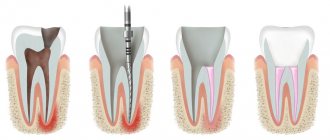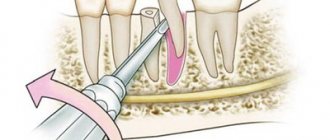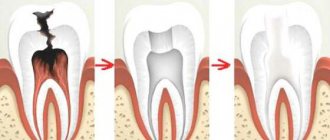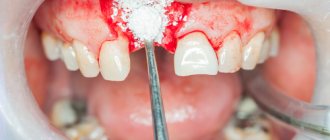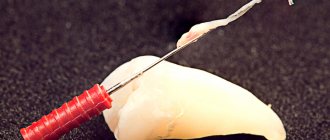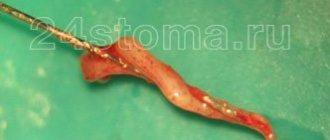One of the most terrifying and frightening procedures for patients is the removal of a nerve from a tooth. Dangerous, painful and expensive - these are the associations that the diagnosis of Pulpitis evokes in most patients of our dentistry. Before medicine in general and dentistry in particular made a big leap forward, pulpitis was indeed a very painful and terrible disease.
But today, when medications, anesthetics, materials, equipment, the qualifications of doctors and their experience have changed for the better, nerve removal has become a common procedure, brought to the point of automation. In this case, the patient does not feel acute pain or intolerable discomfort. Doctors at the Aesthetic Art clinic explain to their patients when tooth nerve removal is required, how the removal procedure goes, whether it hurts and what consequences to expect after the procedure.
Is it painful to remove the nerve of a tooth?
The question of the pain of the process of removing the nerve of a tooth interests many people: most patients think that treating teeth is very painful and this fear is the reason that treatment of caries and pulpitis is postponed until the moment when the tooth can no longer be saved. The fear of dentists is reinforced by reviews on the Internet, in which people describe that their tooth extraction was accompanied by severe pain. But if you start to understand these reviews, you can find out the following important details:
- A person complaining of pain when the nerve of a tooth was removed applied to a state clinic for treatment under the policy. Here we can give the following comment: unfortunately, budget dentistry in our country does not have the required level of equipment, they often use outdated materials and anesthetics;
- The man chose an inexperienced and unqualified doctor to treat his teeth. The anesthetic and its dose are selected individually for each patient, based on the characteristics of the clinical case. If the doctor is incompetent, he may incorrectly calculate the dose of the anesthetic drug and give the injection incorrectly.
If you choose good dentistry to remove a nerve in a tooth, with competent specialists, equipped with all the necessary equipment, tools, advanced drugs and materials, you are guaranteed to receive a high-quality dental treatment service that will take place without pain and discomfort.
In our dental clinic “Firadent”, tooth nerve removal is carried out using highly effective anesthetic drugs, and for patients who are afraid of dentists to the point of panic, we can offer dental treatment and nerve removal under sedation.
YOU NEED TO REMEMBER! Sedation should not be confused with general anesthesia. Sedation is a light medicinal sleep, the use of which in dental treatment has a minimum of contraindications and is not accompanied by severe side effects. During dental treatment under sedation, you will sleep peacefully, and the doctor will perform all the necessary actions. You can read more about sedation or dental treatment during sleep on the website of our dentistry in Moscow - “Firadent”.
Stages of treatment
First of all, the patient is sent for radiography. Diagnostics allows you to determine how many roots a tooth has and choose the most appropriate method of treating the pathology. The following describes the algorithm of actions for removing pulp in one session.
- Anesthesia. First, the injection site is treated with a special agent, after which an anesthetic is administered and left for about 5–15 minutes.
- Preparing the tooth for depulpation. To extract the pulp, it is necessary to provide access to it. To do this, the doctor opens the crown part of the tooth and then removes all affected tissue.
- Removal of the dental nerve. For these purposes, special instruments are used that quickly remove pulp from both the coronal and root parts.
- Installation of a seal. Depending on the location of the tooth, certain filling materials are used for filling - composites, dental cement, etc. Sometimes the doctor will place a temporary filling to ensure that the removal was completed correctly. In this case, a second visit will be required, during which the condition of the tooth is assessed, the temporary filling is removed, and then a permanent one is installed.
With complete removal, the pulp is removed from the coronal and root parts. If the inflammation has affected only the top of the tooth, partial depulpation is performed. In this case, only the coronal part is cut off, and the pulp in the area of the root system remains intact and fully retains its functions.
To make an appointment, call us at the phone number listed on the website. The specialist will answer all your questions and suggest the most convenient time to visit the doctor.
Removing a nerve in a tooth: the consequences of poor-quality treatment
Removing the nerve of a tooth is a complex medical procedure that requires the doctor to have knowledge, experience, and attentiveness during the manipulations. If the dentist makes inaccuracies and mistakes when removing the nerve of a tooth, all this can lead to the development of complications in which it will be impossible to save the tooth.
For example, if, when removing a nerve, part of the instrument breaks off and remains in the dental canal, the tooth cannot be cured in the future and will need to be removed. And the process of removing a broken instrument from a dental canal will be difficult.
After poor-quality removal of a nerve, the tooth may become ill after some time under an already installed permanent filling. The appearance of this complication is explained by the fact that when working with the tooth canals, the doctor did not completely remove damaged and infected tissue from them. If, after removing the nerve of a tooth, the tooth begins to hurt, you should immediately contact the dentist, because the pain syndrome in this case can be a symptom of periodontitis, an inflammatory process that affects the root of the tooth. If periodontitis destroys the root system, it will be impossible to save the tooth; it will have to be removed.
No less important is the use of high-quality filling materials, which are used to restore the natural crown of the tooth after nerve removal. If you choose an inexpensive material, the tooth may subsequently become gray or yellow, and this unpleasant consequence will be impossible to eliminate with regular whitening.
We hope you now understand why it is so important to carefully choose a clinic and a dentist to remove a nerve from a tooth and treat teeth in general. When choosing a clinic, you need to pay attention not to prices and promotions, but to the level of its equipment, and also find out in advance all possible information on the level of qualifications of the dentists working in it.
At the Firadent clinic, the procedure for nerve removal and tooth canal treatment is carried out using a dental microscope - a modern optical device with a powerful magnifying effect. By accurately seeing the area of work and all the tissues of the tooth, the dentist will remove the nerve and affected tissues accurately, without affecting healthy tissues.
YOU NEED TO REMEMBER! If, after removing the nerve, you are bothered by mild pain for several days, then it cannot be attributed to complications and signs of poor-quality treatment. Removal of a nerve involves intervention in the internal structure of the tooth, and therefore pain for some time after this operation is recognized by dentists as a norm that does not require special treatment. In this case, you can eliminate discomfort by taking pharmaceutical painkillers and rinsing.
But if more than a week has passed after removing the nerve of the tooth, and the pain does not go away and, moreover, its intensity is increasing, and the gums in the area of the treated tooth are swollen, you need to urgently contact the dentist who performed your treatment.
Content
- When to remove a nerve
- What to do before visiting the doctor
- How to remove a dental nerve
- How long does it take to remove a nerve?
- Is it painful to remove a nerve?
- Recommendations for care after removal
- Prevention of dental diseases
Each tooth has a pulp in which blood, lymphatic vessels and nerve endings are intertwined. This system is designed to protect the tooth, provide it with nutrition, blood and minerals. After removing the nerve (pulp), the nutrition of the tooth stops, as a result of which it loses some of its properties and will deteriorate faster. If caries is in its initial stage and does not affect the pulp, dental treatment does not involve its removal.
Removal of a nerve in a tooth: price of the service in Moscow
To find out the exact price of the service for removing a nerve in a tooth in Moscow, you need to visit a dentist’s office. Simply calling the clinic in this case will not be enough, because they can tell you the minimum price for removing a nerve in a tooth, for example, they can tell you the cost of treating pulpitis of a single-canal tooth. Naturally, if there are more canals in the tooth, and the tooth is severely damaged, the final cost of removing the nerve of the tooth may turn out to be several times higher than the initially announced amount.
Only a dentist can assess the degree of tooth destruction and the stage of development of inflammation and accurately determine the number of canals in a tooth - after diagnostics.
When is it better to refuse the procedure?
- In general severe condition
- In the last trimester of pregnancy
- During exacerbation of hypertension
- For myocardial infarction
Almost all contraindications are relative; once the condition is normalized, removal of the beam becomes possible.
If it is not possible to postpone the procedure, the tooth is removed. The operation allows you to get rid of pain, but poses new problems, because in this case the dentition will have to be restored.
Removal of a nerve and filling of one canal
Removal of the nerve and filling of one canal is usually performed in the treatment of the upper anterior canines and incisors and lower premolars, which usually have only one canal. In this case, the treatment process will be easier compared to the procedure for removing a nerve from multi-channel teeth. Therefore, its price will be lower.
On average, the cost of removing a nerve and filling one canal in Moscow will cost you 5-6 thousand rubles
. The indicated price will include nerve removal, anesthesia, canal treatment, and tooth restoration with a permanent filling.
YOU NEED TO REMEMBER! As you can see, removing the nerve of a tooth and its subsequent restoration is an expensive procedure, but most importantly, it leads to the tooth becoming dead. If you do not want to spend all your money on dental treatment and wisely save on dental services, do not delay treatment of caries and do not ignore regular preventive examinations at the dentist’s office.
Is it painful to remove a nerve from a tooth?
Previously, when novocaine and lidocaine were used as painkillers, and the nerve was removed by placing a dose of arsenic under a temporary filling, this was real torture.
Today, specialists at the Aesthetic Art clinic offer modern anesthesia methods that eliminate all the unpleasant sensations from the treatment of pulpitis.
We offer our clients the following types of local anesthesia:
Application anesthesia . The area of the mucous membrane where the injection will be given is treated with gel. This is necessary so that there is no unpleasant painful sensation from the injection itself. When treating complex teeth, there may be several such places;
Injection anesthesia . In this case, the drug is injected directly next to the tooth using a syringe. The tooth is chipped from several sides to achieve the most effective pain relief.
Injection anesthesia comes in several types. For each patient, our doctor selects his own type of painkiller, carefully calculating the dose and components of the drug. Even the same patient may be prescribed different anesthesia on different appointment days.
Nerve removal and canal filling: cost of treatment of multi-canal teeth
Different teeth have different numbers of canals, and the more canals a diseased dental unit has, the more difficult and time-consuming will be the removal of the nerve and the process of treating the dental canals. Naturally, the complexity of the treatment will affect its price. The average cost of nerve removal and subsequent treatment of a multi-channel tooth in Moscow is 10-15 thousand rubles
. The indicated amount will include all necessary manipulations, including installation of a permanent filling on the tooth.
Of course, prices for nerve removal and dental treatment are important when choosing a clinic, but should not be the main criterion. It is important not to save money on nerve removal; it is important to carry out treatment in such a way that in a couple of months you do not return to the clinic with a sore tooth and the need to re-treat it, or even remove it altogether!
Our dental clinic in Moscow “Firadent” provides a long-term guarantee for services, which is confirmation that we do our work responsibly!
Indications and contraindications for molar tooth extraction
Dentists try to preserve the crown and root as long as possible, but this is not always possible. Tooth extraction has the following indications:
- it is impossible to apply methods of saving therapy to eliminate the infectious focus;
- acute stage of odontogenic osteomyelitis of the jaws;
- chronically injures the mucous membrane of the mouth or tongue;
- it is not possible to provide drainage from the infectious focus in the jaw;
- is retained, which causes the development of an infectious process;
- his destroyed crown is not suitable for prosthetics;
- periodontitis;
- for malocclusions, when removal can free up space for movements;
- if they are incorrectly located or supernumerary, they cause deformation of the row;
- is the only one on the jaw that interferes with the fixation of a full-fledged jaw prosthesis.
The removal operation has no absolute contraindications, but there are certain situations when the procedure should be postponed. Relative contraindications include conditions that require emergency therapeutic care:
- severe anemia;
- renal failure;
- heart rhythm disturbance;
- acute diseases of internal organs;
- vascular disorders;
- ARVI, influenza;
- chronic heart failure.
Also a contraindication is the first and second trimester of pregnancy.
Is it worth removing the nerve? What could be the consequences if the tooth is not treated?
Depulpation is a last resort. The doctor resorts to it only if this is the only way to avoid tooth extraction. The need to remove the nerve arises when the patient does not contact the dentist on time. The carious process enters a deep stage and affects the pulp. If the nerve is not removed, the toothache will intensify, the inflammation will spread to the periodontium and the tooth will have to be removed. If you have discomfort in the dental area, your teeth have become sensitive, they react to cold, hot, sweets, do not wait until the pain becomes unbearable - sign up for a consultation at our clinic. Perhaps there is still an opportunity to cure your teeth without depulpation. Phone number for appointment +7 495 127-83-36. We work every day from 9 to 21.
Does it hurt
In order to remove the tooth nerve without pain, doctors use anesthesia. Special substances block the nerve endings, the signal does not reach the brain, and pain is not felt.
Local anesthesia
During injection anesthesia, the drug is administered through a syringe. During application, the paste is applied to the desired location. The application method is used as an additional method or to relieve pain in the gums at the injection site.
General anesthesia
Most often used in hospitals. Requires special knowledge and equipment. They are used when it is impossible to apply local anesthesia, for certain diseases of the heart and lungs, and for large carious cavities for their simultaneous sanitation.
For successful treatment, the patient’s psychological mood is of great importance. The dentist’s task is to reduce psycho-emotional stress and anxiety. Light music, flowers, paintings, attentive, polite staff help the patient to relax. Mild sedatives reduce stress levels.
